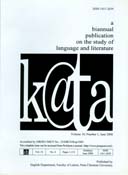Reading Through Emotions: An Affective Narratolological Approach to Alice Munro's Short Stories
Abstract
The emergence of fields of study like emotionology, affective narratology, and psychonarratology in recent decades evidences a dramatic rise in research done on the meaning and interpretation of emotions. Affective Narratology as one of the recent fields in emotion studies attempts to identify and account for the figuration of emotions in works of literature. Focusing on three basic emotions (shame, jealousy and love) figuring in Alice Munro’s selected short stories this paper probes the significance of emotional registers in the writer's depiction of daily life. Examined is the way the stories' sincere tone and their comprehensible, ordinary language, contribute to the emotional identification of readers with characters. Applying affective narratological theories, the objective is to show how emotions contribute to plot development and characterization in these stories. Central to the analysis is interpreting emotional moments experienced by characters, especially female characters
Downloads
References
Andersen, P. T. (2016). Story and emotion: A study in affective narratology (M. Hult, trans.) Oslo: Universitetsforlaget.
Carrington, I. d. P. (1989). Controlling the uncontrollable: The fiction of Alice Munro. Dekalb: Northern Illinois University Press.
Dixon, T. (2003). From passions to emotions: The creation of a secular psychological category. New York: Cambridge University Press.
Fisher, P. (2002). The Vehement Passions. Princeton, N.J.: Princeton University Press.
Hogan, P. C. (2011a). Affective narratology: The emotional structure of stories. Lincoln: University of Nebraska Press.
Hogan, P. C. (2011). What Literature Teaches Us about Emotion. Cambridge University Press.
Kristjánsson, K. (2002). Justifying Emotions: Pride and Jealousy. Routledge.
Miner, R. (2009). Thomas Aquinas on the Passions. Cambridge University Press.
Munro, A. (1991). Friend of My Youth. In A. Munro, Friend of my youth (pp. 3-26). New York: Vintage Books.
Munro, A. (2005). Passion. In A. Munro, Run away (pp. 159-196) New York: Vintage Books.
Munro, A. (2008). The View from the Castle Rock. In A. Munro, The view from the castle rock (pp. 27-87). New York: Vintage Books.
Munro, A. (2010). Too Much Happiness. In A. Munro, Too much happiness (pp. 247-304). New York: Vintage Books.
Munro, A. (2015). Lives of Girls and Women. In A. Munro, Lives of girls and women (pp. 180-223). New York: Vintage Books.
Oatley, K. (2004). Emotions: A Brief History. Malden, M.A.: Blackwell Publishing Ltd.
Palmer, A. (2010). Story worlds and groups." In L. Zunshine (Ed.), Introduction to cognitive cultural studies (pp. 176-192). Baltimore, M.D.: Johns Hopkins University Press.
Robinson, J. (2005). Deeper Than Reason: Emotion and its Role in Literature, Music, and Art. New York: Oxford University Press.
Tarasti, E. (2017). The Semiotics of A. J. Greimas: European intellectual heritage seen from the inside and the outside. Sign Systems Studies, 45(1/2), 33-53. https://doi.org/10.12697/SSS. 2017.45.1-2.03.
Toolan, M. (2012). Engagement via emotional heightening in “Passion”: On the grammatical texture of emotionally-immersive passages in short fiction. Narrative, 20(2), 210-225. http://doi.org/ 10.1353/nar.2012.0009

This work is licensed under a Creative Commons Attribution 4.0 International License.
This work is licensed under a Creative Commons Attribution License


















